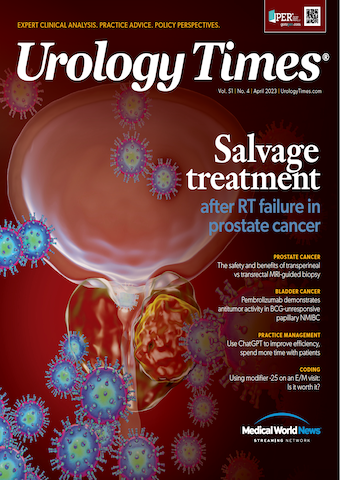Publication
Article
Urology Times Journal
The safety and oncologic benefits of transperineal vs transrectal MRI-guided prostate biopsy
Author(s):
"These studies, taken together, offer important insight into the direction we should be heading in prostate cancer diagnosis: toward a targeted-only TP biopsy," write Tarik Benidir, MD, and Zeyad Schwen, MD.
Tarik Benidir, MD

Transperineal biopsy (TP) for prostate cancer diagnosis has become standard of care in Europe, as seen by the “level 1a” recommendation in the most recent European Association of Urology guidelines.1 While we await the National Comprehensive Cancer Network and American Urological Association/Canadian Urological Association updated guidelines on the management of localized prostate cancer, one can only assume there will be a recommendation or suggestion regarding this topic. So where does this level 1a evidence come from?
So where does this level 1a evidence come from?
Zeyad Schwen, MD

Three well-conducted studies have explored the safety outcomes of men treated with TP vs transrectal (TR) biopsy. The first study was a meta-analysis of 7 randomized studies in 1330 patients2 showing a relative risk increase of 1.81 (95% CI, 1.09-3.00) for infectious complications when performing TR vs TP biopsy.1 Thereafter, a systematic review of 165 studies with more than 162,000 patients demonstrated a lower sepsis rate for TP (0.1%) vs TR (0.9%).3 TP’s safety profile was further confirmed with a UK population–based study on nearly half a million patients, with the outcome of sepsis and infection favoring TP (0.31%) vs TR (0.53%).4
The improved safety profile in favor of TP makes biological sense because the entry is skin to prostate rather than rectal mucosa to prostate.
From a targeting standpoint, TP biopsies sample the prostate with an apex-to-base rather than posterior-to-anterior orientation. As such, using a TP approach on lesions that are difficult to reach via TR biopsy, such as anterior and apical lesions, may have better accuracy. This hypothesis was suggested when men undergoing active surveillance for low-risk prostate cancer had higher rates of disease upgrade to clinically significant prostate cancer (csPCa) when they repeatedly underwent TP rather than TR biopsies.5 Conversely, no differences in the diagnosis of csPCa was seen between TP and TR when one performed a systematic-only biopsy approach.6 Taken together, these studies suggest that the added value of a TP biopsy is with a targeted rather than systematic approach.
This hypothesis was further supported with a systematic review showing an improved sensitivity for csPCa when performing an MRI-guided TP vs TR biopsy (86% vs 73%).7 Finally and most recently, a multicenter, retrospective cohort study explored whether an MRI-targeted TP (n = 3305) vs TR (n = 1936) biopsy approach influenced the predictive accuracy of prostate cancer and csPCa. The investigators found that the rate of csPCa was significantly improved with the TP approach compared with the TR approach (49% vs 35%) and that MRI-targeted TP biopsy was an independent predictor for prostate cancer and csPCa (P < .001).8
Based on this body of evidence, targeting an MRI-visible lesion yields that best chance of csPCa when performed via a TP rather than TR approach.
Since TP is more accurate for csPCa, can the systematic portion of the template biopsy be omitted? The randomized GÖTEBORG-2 clinical trial (ISRCTN94604465) aimed to address this question by exploring the difference between MRI-targeted biopsy and systematic biopsy plus MRI-targeted biopsy, with the primary outcome being clinically insignificant prostate cancer detection rates. Within this screening study involving 38,775 men, those with a prostate-specific antigen (PSA) level of at least 3 ng/mL were randomly assigned to either the reference group (systematic or systematic + targeted) or the experimental group (targeted only if PSA 3-10 ng/mL, systematic +/- targeted if PSA > 10 ng/mL). Biopsies were all transrectally approached and included 10 systematic biopsies when indicated and 4 targeted when indicated. The results revealed that performing a targeted-only approach reduced the rate of clinically insignificant prostate cancer detection (0.6% vs 1.2%), with a relative risk reduction of 0.46 (95% CI, 0.33-0.64; P < .001). The detection of csPCa was 0.9% for the experimental group vs 1.1% for the reference group (a reduction of 19% for the experimental group). Further analysis demonstrated that of the csPCa detected by systematic biopsy alone (n=10), most were small volume grade group 2, suggesting that one could potentially omit systematic biopsy in men being screened for prostate cancer.9
These studies, taken together, offer important insight into the direction we should be heading in prostate cancer diagnosis: toward a targeted-only TP biopsy. This makes sense with new evidence suggesting a targeted-only approach is feasible and with the growing body of literature suggesting that a TP biopsy is safer and has a better cancer detection rate.
Although the evidence of a TP targeted–only approach is promising and warrants further investigation, it does increase the possibility of reducing the diagnosis and treatment of clinically insignificant disease, reducing the number of biopsies performed, cutting costs, and minimizing the morbidity associated with prostate cancer diagnosis.
References
1. Prostate cancer. European Association of Urology. Accessed December 13, 2022. https://bit.ly/3BBtr4d
2. Pradere B, Veeratterapillay R, Dimitropoulos K, et al. Nonantibiotic strategies for the prevention of infectious complications following prostate biopsy: a systematic review and meta-analysis. J Urol. 2021;205(3):653-663. doi:10.1097/JU.0000000000001399
3. Bennett HY, Roberts MJ, Doi SA, Gardiner RA. The global burden of major infectious complications following prostate biopsy. Epidemiol Infect. 2016;144(8):1784-1791. doi:10.1017/S0950268815002885
4. Tamhankar AS, El-Taji O, Vasdev N, Foley C, Popert R, Adshead J. The clinical and financial implications of a decade of prostate biopsies in the NHS: analysis of Hospital Episode Statistics data 2008-2019. BJU Int. 2020;126(1):133-141. doi:10.1111/bju.15062
5. Meyer AR, Mamawala M, Winoker JS, et al. Transperineal prostate biopsy improves the detection of clinically significant prostate cancer among men on active surveillance. J Urol. 2021;205(4):1069-1074. doi:10.1097/JU.0000000000001523
6. Huang GL, Kang CH, Lee WC, Chiang PH. Comparisons of cancer detection rate and complications between transrectal and transperineal prostate biopsy approaches - a single center preliminary study. BMC Urol. 2019;19(1):101. doi:10.1186/s12894-019-0539-4
7. Tu X, Liu Z, Chang T, et al. Transperineal magnetic resonance imaging-targeted biopsy may perform better than transrectal route in the detection of clinically significant prostate cancer: systematic review and meta-analysis. Clin Genitourin Cancer. 2019;17(5):e860-e870. doi:10.1016/j.clgc.2019.05.006
8. Zattoni F, Marra G, Kasivisvanathan V, et al. The detection of prostate cancer with magnetic resonance imaging-targeted prostate biopsies is superior with the transperineal vs the transrectal approach. A European Association of Urology-Young Academic Urologists Prostate Cancer Working Group multi-institutional study. J Urol. 2022;208(4):830-837. doi:10.1097/JU.0000000000002802
9. Hugosson J, Månsson M, Wallström J, et al; GÖTEBORG-2 Trial Investigators. Prostate cancer screening with PSA and MRI followed by targeted biopsy only. N Engl J Med. 2022;387(23):2126-2137. doi:10.1056/NEJMoa2209454

































